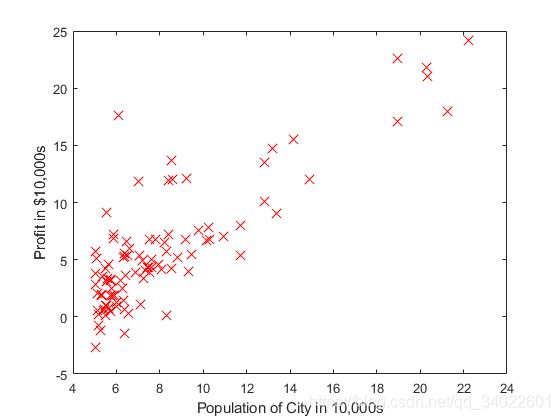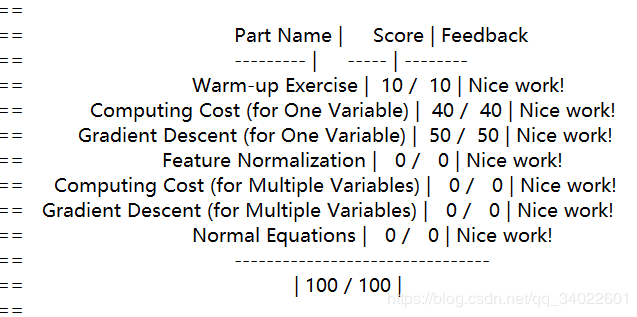吴恩达机器学习作业讲解(含代码)——ex1(线性回归)
详细代码链接:h5ww
Programming Exercise 1: Linear Regression
Files included in this exercise
你必须要完成以下的函数:
- warmUpExercise.m - 简单的样例函数
- plotData.m - 显示数据集的函数
- computeCost.m - 线性回归的代价函数
- gradientDescent.m - 执行梯度下降算法
你可以额外完成以下函数:
- computeCostMulti.m - 多元变量的代价函数
- gradientDescentMulti.m - 多元变量的梯度下降
- featureNormalize.m - 变量正规化
- normalEqn.m - 计算正规方程
warmUpExercise.m
要求返回一个5x5的单位向量,文档里给了代码.
% ============= YOUR CODE HERE ==============
% Instructions: Return the 5x5 identity matrix
% In octave, we return values by defining which variables
% represent the return values (at the top of the file)
% and then set them accordingly.
A = eye(5);
% ===========================================plotData.m
要求在坐标图上画出每个数据点,文档中也同样给出了代码
figure; % 打开新的窗口
% ====================== YOUR CODE HERE ======================
% Instructions: Plot the training data into a figure using the
% "figure" and "plot" commands. Set the axes labels using
% the "xlabel" and "ylabel" commands. Assume the
% population and revenue data have been passed in
% as the x and y arguments of this function.
%
% Hint: You can use the 'rx' option with plot to have the markers
% appear as red crosses. Furthermore, you can make the
% markers larger by using plot(..., 'rx', 'MarkerSize', 10);
plot(x,y,'rx','MarkerSize',10);
% plot(x,y,点的样式(r=red,x为叉型),标记大小,设置标记大小为10)
ylabel('Profit in $10,000s');
% 设置y轴标签
xlabel('Population of City in 10,000s');
% 设置x轴标签
% ============================================================
效果:
computeCost.m
复习一下线性回归的函数:
![]()
data = load('ex1data1.txt');
X = data(:, 1); y = data(:, 2);
m = length(y); % number of training examples
...
X = [ones(m, 1), data(:,1)]; % Add a column of ones to x
theta = zeros(2, 1); % initialize fitting parameters
...
% compute and display initial cost
J = computeCost(X, y, theta);从代码中看出X作为数据矩阵,大小为![]() ,y矩阵大小为
,y矩阵大小为![]() ,theta(
,theta(![]() )大小为
)大小为![]() .
.
我们直接利用线性代数只通过一次矩阵运算直接获得![]() 的值。
的值。
![]() ,直接一步到位等于
,直接一步到位等于 ![]() (
(![]() )
)
![]() 这是矩阵的乘法运算规律,得到的是一个数。
这是矩阵的乘法运算规律,得到的是一个数。
最后这个数除2*m即可。
% ====================== YOUR CODE HERE ======================
% Instructions: Compute the cost of a particular choice of theta
% You should set J to the cost.
% x*theta get Matrix m*1
x= X*theta-y;
J=(x'*x)/(2*m);
% =========================================================================
gradientDescent.m
梯度下降的更新公式:
注意的是所有的![]() 需要同时更新,同一次迭代中的
需要同时更新,同一次迭代中的![]() 是不相互影响的。
是不相互影响的。
同样为了运算的直观和方便,也可直接使用矩阵运算,一次运算的到结果。
![]() 是
是![]() (
(![]() )。
)。
![]() 要对
要对![]() 中每一列都进行一次求内积。然而
中每一列都进行一次求内积。然而![]() 是一个
是一个![]() 的列向量,所以
的列向量,所以![]() 先对转置[
先对转置[![]() --
--![]() ],在和
],在和![]() 相乘。
相乘。
for iter = 1:num_iters
% ====================== YOUR CODE HERE ======================
% Instructions: Perform a single gradient step on the parameter vector
% theta.
%
% Hint: While debugging, it can be useful to print out the values
% of the cost function (computeCost) and gradient here.
%
x=(alpha*(1/m))*(X'*((X*theta)-y));
theta=theta-x;
% ============================================================
% Save the cost J in every iteration
J_history(iter) = computeCost(X, y, theta);
endcomputeCostMulti.m
多元线性回归的代价函数计算与2元的计算公式 一样。我是利用矩阵运算的,所以不管是多少位变量,都可以一次计算成功。
代码和 computeCost.m 中一样。
% ====================== YOUR CODE HERE ======================
% Instructions: Compute the cost of a particular choice of theta
% You should set J to the cost.
% x*theta get Matrix m*1
x= X*theta-y;
J=(x'*x)/(2*m);
% =========================================================================
gradientDescentMulti.m
矩阵运算优越性就是这样,代码还是一样。
x=(alpha*(1/m))*(X'*((X*theta)-y));
theta=theta-x;featureNormalize.m
变量过多也带来了很多问题,不同变量的大小范围是不同的。比如![]() ,但是在梯度下降更新中学习率
,但是在梯度下降更新中学习率![]() 一般都是0<
一般都是0<![]() <1的,这个导致了在
<1的,这个导致了在![]() 对应的
对应的![]() 更新很慢。这个导致了整体效率的降低。于是,我们引入变量归一化。归一化的目的是把数变为(0,1)之间的小数。这样我们的更新效率会有所提高。
更新很慢。这个导致了整体效率的降低。于是,我们引入变量归一化。归一化的目的是把数变为(0,1)之间的小数。这样我们的更新效率会有所提高。
归一化的公式是:![]() 。
。![]() 是被归一化的变量集合,
是被归一化的变量集合,![]() 是
是![]() 的平均值,
的平均值,![]() 是
是![]() 的标准差或偏差。
的标准差或偏差。
这里我们使用标准差。MATLAB中使用mean(x),std(x)分别求均值![]() 和标准差
和标准差![]() 。
。
%遍历X的每一列,对每一列求均值和标准差
%均值存在mu中,标准差存在sigma中,归一化结果存在X_norm中
for i=1:size(X,2)
mu(i)=mean(X(:,i));
sigma(i)=std(X(:,i));
X_norm(:,i)=(X(:,i)-mu(i))/sigma(i);
endnormalEqn.m
吴恩达在课程中讲过正规方程一步求解最有解的方法。
![]()
这个方法通常在X大小适中的时候使用,否在效率会比梯度下降低。
n是指变量的个数。
% ---------------------- Sample Solution ----------------------
theta=pinv((X'*X))*X'*y;
% -------------------------------------------------------------


